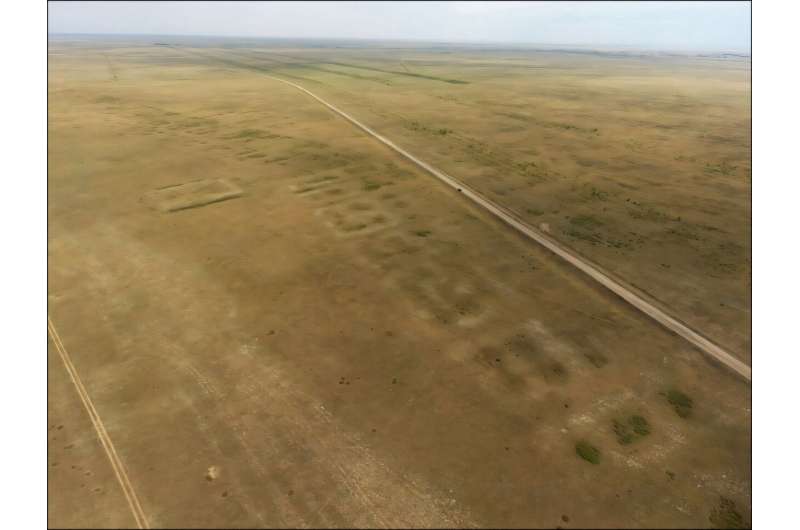Science
Archaeologists Uncover Bronze Age Metropolis in Kazakhstan

An international team of archaeologists has unearthed the remains of a vast Bronze Age settlement named Semiyarka, located in the Kazakh steppe. This significant discovery is reshaping our understanding of urban life and metallurgy in prehistoric Eurasia. The site, covering approximately 140 hectares, sits prominently above the Irtysh River in northeastern Kazakhstan, marking one of the most important findings in steppe archaeology in recent decades.
Unveiling a Planned Settlement
Known as the “City of Seven Ravines,” Semiyarka is distinguished by its strategic position above a network of valleys. This settlement thrived around 1600 BC and represents an early form of city, characterized by rectilinear earthworks, enclosed household compounds, and a central monumental building that may have served ritual or governance purposes.
In contrast to the typical mobile steppe communities, which are often associated with scattered camps and small villages, Semiyarka presents a complex urban structure. The discovery of an industrial zone dedicated to the production of copper and tin bronze indicates a level of metallurgical activity previously unseen in this region. Excavations and geophysical surveys have uncovered crucial artifacts, including crucibles and tin bronze items, providing the first solid evidence that steppe metallurgists operated intricate production systems rather than small-scale workshops.
Strategic Location and its Implications
The site’s location on a promontory controlling movement along the Irtysh River valley suggests that Semiyarka was not only a production centre but also a hub for trade and regional power. Its proximity to significant deposits of copper and tin in the Altai Mountains indicates it may have played a vital role in the extensive Bronze Age metal networks connecting Central Asia with wider regions.
The investigation was spearheaded by Dr. Viktor Merz and Dr. Ilya Merz from the Joint Research Center for Archaeological Studies at Toraighyrov University, alongside Dr. Miljana Radivojević from the UCL Institute of Archaeology and Professor Dan Lawrence from Durham University. Their collaborative efforts, now documented in the journal Antiquity, employed advanced methods to reconstruct the social and technological landscapes of Bronze Age Kazakhstan.
Dr. Radivojević remarked, “Semiyarka transforms our understanding of steppe societies. It demonstrates that mobile communities were capable of building and sustaining permanent, well-organized settlements centered on large-scale metallurgical production.” Professor Lawrence added, “The scale and structure of Semiyarka are unlike anything else we’ve seen in the steppe zone.”
Reflecting on the extensive research conducted at the site, Dr. Merz expressed enthusiasm for the collaboration, stating, “Working with colleagues from UCL and Durham has brought new methods and perspectives, and I look forward to what the next phase of excavation will reveal.”
As investigations continue, Semiyarka stands as a testament to the urban ingenuity that once thrived in the grasslands of Central Asia, showcasing a Bronze Age city that rivals those of other ancient civilizations. The revelations from this site promise to deepen our understanding of the complex societies that existed in this region thousands of years ago. More information about this groundbreaking research can be found in the article “A major city of the Kazakh Steppe? Investigating Semiyarka’s Bronze Age legacy,” published in Antiquity.
-

 Top Stories1 month ago
Top Stories1 month agoNew ‘Star Trek: Voyager’ Game Demo Released, Players Test Limits
-

 World1 month ago
World1 month agoGlobal Air Forces Ranked by Annual Defense Budgets in 2025
-

 World1 month ago
World1 month agoMass Production of F-35 Fighter Jet Drives Down Costs
-

 World1 month ago
World1 month agoElectrification Challenges Demand Advanced Multiphysics Modeling
-

 Science1 month ago
Science1 month agoTime Crystals Revolutionize Quantum Computing Potential
-

 Business1 month ago
Business1 month agoGold Investment Surge: Top Mutual Funds and ETF Alternatives
-

 Entertainment1 month ago
Entertainment1 month agoFreeport Art Gallery Transforms Waste into Creative Masterpieces
-

 Top Stories1 month ago
Top Stories1 month agoDirecTV to Launch AI-Driven Ads with User Likenesses in 2026
-

 Lifestyle1 month ago
Lifestyle1 month agoDiscover Reese Witherspoon’s Chic Dining Room Style for Under $25
-

 Health1 month ago
Health1 month agoGavin Newsom Critiques Trump’s Health and National Guard Plans
-

 Science1 month ago
Science1 month agoRemembering David E. Brest: A Life Dedicated to Nature and Family
-

 Lifestyle1 month ago
Lifestyle1 month agoLia Thomas Honored with ‘Voice of Inspiration’ Award at Dodgers Event








